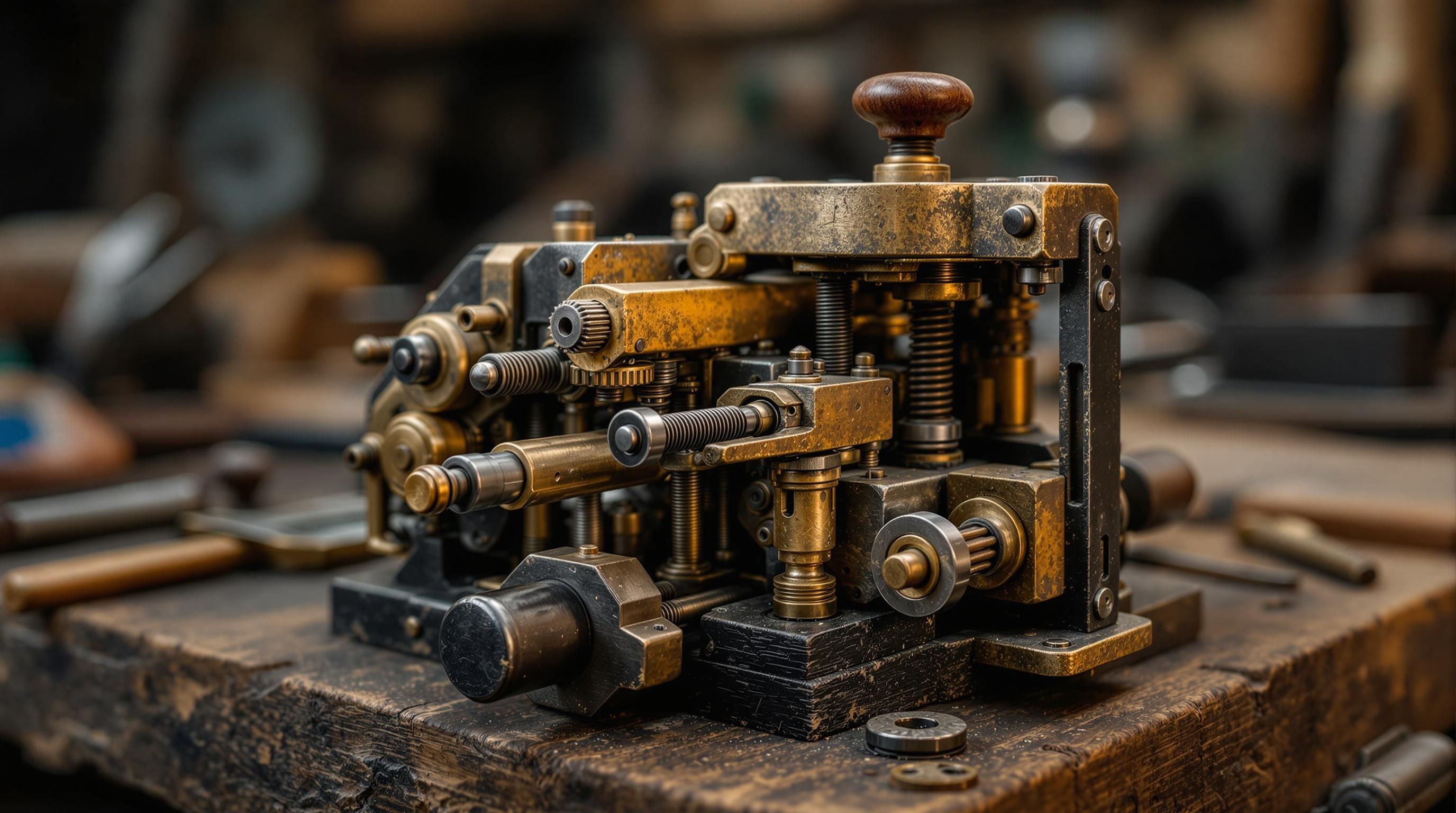Uncovering unusual antique hand tools can be like discovering hidden treasure. Whether found in a dusty barn, inherited from a relative, or spotted at an estate sale, these mysterious implements often leave modern collectors puzzled about their original purpose, age, and value.
Unlike common antique tools such as hammers or saws, unusual specimens present unique identification challenges. Their specialized functions may be obsolete in today’s world, making them particularly difficult to recognize and properly authenticate.
This comprehensive guide will walk you through the process of identifying and valuing unusual antique hand tools, from deciphering maker’s marks to understanding historical context that informs their significance. Whether you’re a seasoned collector or simply curious about a strange old tool you’ve discovered, you’ll find valuable insights to help solve these fascinating historical puzzles.
The Appeal of Unusual Antique Hand Tools
The fascinating world of unusual antique tools reveals ingenuity from a time when specialized tasks required custom-designed implements. These tools represent the problem-solving approach of craftsmen who created specific solutions for particular challenges in their trades.
For collectors, the appeal lies in several key factors:
Historical Significance: Unusual tools provide glimpses into forgotten trades and techniques, preserving knowledge that might otherwise be lost to history.
Craftsmanship: Many antique tools showcase remarkable craftsmanship, from hand-forged metals to beautifully turned wooden handles with intricate details.
Scarcity: Unusual or specialized tools were often produced in limited quantities, making them particularly valuable to today’s collectors.
Educational Value: These tools help us understand how historical craftsmen approached their work, offering insights into pre-industrial manufacturing methods.
Collectors often focus on specific categories like woodworking, blacksmithing, leatherworking, or agricultural implements. Others seek tools from particular regions, time periods, or manufacturers. Whatever your interest, learning to identify unusual specimens is the first step toward building a meaningful collection.
Antique Tool Market Highlights
Key Features for Identifying Unusual Antique Hand Tools
When faced with an unusual tool whose purpose isn’t immediately obvious, systematic examination is your best approach. Focus on these crucial identification factors:
Materials and Construction
Materials can provide valuable clues about a tool’s age and origin:
- Wood Types: Different woods were favored in different regions and time periods. Oak, maple, beech, and rosewood were commonly used in quality tools.
- Metal Composition: Early tools often feature wrought iron, while later tools might incorporate cast iron, steel, or brass components.
- Construction Methods: Hand-forged metal parts, hand-cut dovetails, and other signs of hand craftsmanship typically indicate older specimens.
- Patina: The natural aging of materials creates distinctive patinas; artificially aged reproductions often lack the subtle variations of genuine antiques.
Maker’s Marks and Manufacturer Identification
Many antique tools bear identifying marks that can significantly help with identification:
- Maker’s Marks: Look for stamped, engraved, or embossed names, initials, or symbols on metal parts.
- Company Logos: Established manufacturers like Stanley, Disston, or Millers Falls had distinctive logos that evolved over time.
- Location Information: Some tools include city or country of origin that can help pinpoint their manufacture.
Patent Information and Dating
Patent marks provide perhaps the most precise dating information:
- Patent Dates: Many tools include patent dates, which establish the earliest possible manufacture date.
- Patent Numbers: With patent numbers, you can research the original patent documentation for detailed information about the tool’s intended use and inventor.
- **“Pat. Applied For” or “PAT PEND”: These marks indicate the tool was manufactured after a patent application but before it was granted.
Tool Design and Functionality
Understanding a tool’s function is essential for proper identification:
- Tool Form: The overall shape and configuration often relates directly to its purpose.
- Specialized Features: Unusual cutting edges, adjustable components, or special fixtures may indicate specialized functions.
- Wear Patterns: How a tool has worn over time can suggest how it was used.
Antique Tool Inspection Checklist
Examine your unusual antique tool for these important identification markers
- Check metal surfaces for maker's marks, logos, or patent information
- Examine wooden handles for manufacturer stamps or decals
- Look for patent dates or numbers (often preceded by 'PAT.' or 'PATD.')
- Identify primary materials (type of wood, metal composition)
- Note construction methods (hand-forged, cast, machined)
- Assess overall condition and authenticity of patina
- Measure the tool and document any unique features
- Photograph from multiple angles including any markings
Categories of Unusual Antique Hand Tools
Unusual antique tools generally fall into specific trade categories, each with its own specialized implements. Recognizing which trade a mystery tool might belong to can significantly narrow down identification possibilities.
Specialized Woodworking Tools
Woodworking boasts perhaps the widest variety of specialized antique tools:
- Molding Planes: Specially shaped planes for creating decorative moldings, with hundreds of profile variations.
- Cooperage Tools: Specialized implements for barrel-making, including crozes, howels, and chamfer knives.
- Chairmaking Tools: Travishers, inshaves, and scorp tools used in crafting Windsor and other traditional chairs.
- Measuring and Layout Tools: Unusual calipers, bevels, and marking tools specific to furniture-making.
Unusual Metalworking Tools
Blacksmithing and other metalworking trades required numerous specialized tools:
- Farrier’s Tools: Specialized hammers, nippers, and rasps used in horseshoeing.
- Tinsmith’s Tools: Stakes, mallets, and forming tools for shaping sheet metal.
- Jeweler’s Tools: Precision implements for metalwork on a miniature scale.
- Watchmaker’s Tools: Highly specialized tools for clock and watch repair and production.
Agricultural and Rural Trade Tools
Farm and rural trades developed numerous purpose-specific implements:
- Harvest Tools: Specialized knives, hooks, and flails for specific crops.
- Animal Husbandry Tools: Unusual implements for livestock care and management.
- Fence-Making Tools: Specialized tools for traditional fencing methods.
- Logging and Forestry Tools: Specialized axes, bark spuds, and timber-moving devices.

Specialized Construction and Building Tools
Building trades developed tools for specific architectural elements:
- Plasterwork Tools: Specialized trowels and combs for decorative plasterwork.
- Masonry Tools: Unusual tools for stone shaping and specialized brickwork.
- Roofing Tools: Specialized implements for different roofing materials.
- Glass Working Tools: Tools for cutting, handling, and installing glass.
Leather and Textile Working Tools
Leather and textile trades required numerous specialized tools:
- Leatherworking Tools: Specialized knives, punches, and edge tools.
- Shoemaking Tools: Lasting pliers, sole cutters, and specialized awls.
- Textile Tools: Unusual looms, shuttles, and specialized weaving implements.
- Sailmaking Tools: Specialized needles, palms, and forming tools.
Evolution of Tool Manufacturing
- Pre-1800
Hand-Forged Era
Tools individually crafted by blacksmiths. Look for: irregular hammer marks, wrought iron construction, minimal standardization. - 1800-1860
Small Manufacturer Period
Rise of specialized toolmakers. Look for: consistent forms, early maker's marks, use of cast steel, early factory production methods. - 1860-1900
Patent Explosion Era
Proliferation of specialized patented designs. Look for: patent dates, innovation in tool designs, increased use of cast parts. - 1900-1940
Industrial Consolidation
Large companies dominate. Look for: standardized designs, detailed maker's marks, mass production techniques. - Post-1940
Modern Era
Decline of specialized hand tools. Look for: increased use of modern materials, simplified designs, eventual replacement by power tools.
Research Methods for Unusual Tool Identification
Identifying truly unusual antique tools often requires detective work beyond basic observation. Here are effective research methods to help solve these historical mysteries:
Reference Books and Catalogues
Published resources provide valuable identification information:
- Tool Collector Guides: Books like “Antique & Collectible Tools” by Ronald S. Barlow or “Antique Tools: Our American Heritage” by Kathryn McNerney contain thousands of tool illustrations.
- Manufacturer Catalogues: Historical tool catalogs from companies like Stanley, Sargent, or Keen Kutter can help identify unusual specimens.
- Patent Digests: Publications compiling historical patents often include detailed drawings and descriptions of specialized tools.
- Trade-Specific Resources: Books focused on particular trades often document the specialized tools used in those professions.
Online Resources and Databases
The internet offers powerful identification tools:
- Online Museum Collections: The National Museum of American History, the Early American Industries Association, and other institutions have searchable tool collections.
- Patent Databases: The US Patent Office’s database allows searches of historical patents if you have a patent number or date.
- Collector Forums: Websites like Antique & Vintage Tools Discussion Group connect you with knowledgeable collectors.
- Auction Archives: Records from specialized tool auctions can help identify and value unusual specimens.
Expert Consultation
When all else fails, consult with experts:
- Antique Tool Dealers: Specialized dealers often have extensive knowledge about unusual tools.
- Museum Curators: Many historical museums employ curators with expertise in historical trades and tools.
- Collector Organizations: Groups like the Mid-West Tool Collectors Association or the Early American Industries Association have members with deep expertise.
- Trade Practitioners: Modern practitioners of traditional crafts often maintain knowledge about historical tools related to their trades.

Collective Intelligence Platforms
Crowdsourcing can help identify particularly mysterious tools:
- “What Is It?” Columns: Publications like The Chronicle (EAIA) and The Gristmill (MWTCA) feature reader-submitted mystery tools.
- Social Media Groups: Specialized groups dedicated to antique tools can provide rapid identification from collective expertise.
- Mystery Tool Pages: Websites like LeToolMan’s Mystery Tool Page feature unusual tools submitted by readers.
- Reddit Communities: Subreddits like r/handtools often help identify unusual specimens.
Unusual Antique Hand Tool Value Ranges
Current market values based on recent sales and auction results
</tbody>
</table>
Valuation Factors for Unusual Antique Tools
The value of unusual antique tools depends on multiple factors. Understanding these can help you accurately assess a tool’s worth in today’s collector market:
Rarity and Scarcity
Rarity significantly impacts valuation:
- Limited Production Runs: Tools manufactured in small quantities naturally command higher prices.
- Regional Rarities: Tools specific to particular geographic regions may be common in one area but rare elsewhere.
- Survival Rate: Some tools had high attrition rates due to heavy use or fragile materials, making well-preserved examples rare today.
- Documented Provenance: Tools with documented history related to significant craftsmen or historical events carry premium values.
Condition Assessment
Condition remains crucial to value:
- Completeness: All original parts present without replacements or modifications.
- Functionality: Tools that still function as intended are typically more valuable.
- Original Finish: Preservation of original paint, japanning, or patina enhances value.
- Structural Integrity: Absence of cracks, breaks, or repairs in both metal and wooden components.
Collector Demand and Market Trends
Market dynamics influence tool values:
- Collector Focus Areas: Tools from currently popular collecting categories command premium prices.
- Research Publications: Recently published books or articles about particular tool types often drive interest and prices.
- Museum Exhibitions: Public displays featuring certain tool types can increase collector awareness and demand.
- Investment Potential: Tools perceived as having appreciation potential may sell for premium prices.
Historical and Educational Significance
Historical context affects value:
- Innovation Representation: Tools that represent important innovations or patents typically command higher prices.
- Cultural Significance: Tools that tell important stories about historical work practices or cultural traditions.
- Documented Usage: Tools with documentation showing their use in significant historical contexts.
- Educational Value: Tools that clearly demonstrate historical techniques or manufacturing methods.
Notable Unusual Antique Tool Auction Results
Recent sales of rare and unusual antique hand tools
| Category | Price | Notes |
|---|---|---|
| Rare Patented Tools (Documented) | $500-$20,000+ | Value depends on rarity, condition, and historical significance |
| Specialized Woodworking Tools | $100-$1,500 | Higher values for ornate molding planes and patented designs |
| Unusual Measuring Instruments | $75-$800 | Brass instruments and early examples command premium prices |
| Specialized Agricultural Tools | $50-$600 | Regional variations and unusual designs increase value |
| Obscure Trade-Specific Tools | $40-$400 | Value increases with rarity and documentation of purpose |
</tbody>
</table>
Authentication and Spotting Reproductions
Authenticating unusual antique tools requires careful examination and knowledge of common reproduction indicators. Here’s how to spot the genuine articles:
Materials and Construction Analysis
Authentic materials show specific characteristics:
- Wood Aging: Genuine antique wood develops characteristic aging patterns that are difficult to fake, including subtle darkening and shrinkage.
- Tool Marks: Authentic old tools often show period-appropriate tool marks from their manufacture.
- Metal Composition: Older tools often used metals with different compositions than modern reproductions.
- Aging Process: Natural patina develops differently than artificial aging processes used on reproductions.
Common Reproduction Red Flags
Watch for these warning signs:
- Inconsistent Wear Patterns: Reproductions often show artificial wear that doesn’t match how the tool would actually have been used.
- Anachronistic Features: Details inconsistent with the purported age, such as modern fasteners or manufacturing techniques.
- Over-Pristine Condition: Tools claiming great age yet showing remarkably little wear may be suspicious.
- Artificially Aged Finishes: Chemical aging that produces unnaturally consistent coloration or artificial-looking patina.
Historical Manufacturing Techniques
Understanding historical manufacturing methods helps with authentication:
- Hand-Forged Elements: Authentic old hand-forged parts show hammer marks and irregularities consistent with manual production.
- Historic Joinery Methods: Genuine old wooden tool parts typically show period-appropriate joinery techniques.
- Period-Appropriate Finishes: Different eras used characteristic finishing techniques on both wood and metal.
- Casting Techniques: Cast parts show characteristics specific to the casting methods of their era.
Expert Verification Resources
When in doubt, seek expert verification:
- Professional Appraisers: Specialists in antique tools can provide authentication services.
- Museum Conservators: Many historical museums offer identification services.
- Specialized Testing: For valuable specimens, materials testing can determine authentic age.
- Documentation Research: Patent records, manufacturer catalogs, and historical archives can verify authentic examples.
Antique Tool Identification Resources
Jim Bode Tools Value Guide
Comprehensive guide to antique tool values with detailed descriptions and authentication information.
LeToolMan's Mystery Tool Page
Extensive collection of unusual and mysterious antique tools with identification information.
LoveToKnow Antique Tools Identification Guide
Detailed guide for identifying antique hand tools with information on maker's marks and valuation.
Vintage Tool Discussion & Identification Group
Active Facebook community with experts who help identify unusual and rare antique tools.
Early American Industries Association
Organization dedicated to preserving and presenting historic trades, tools, and crafts with extensive resources.
Mid-West Tool Collectors Association
Large community of tool collectors with educational resources and regional meetings for tool identification.
Handtools Subreddit
Active Reddit community where users help identify unusual tools and discuss antique tool collecting.
Alloy Artifacts Tool History Page
Detailed historical information on tool manufacturers and their marks to aid in identification.
Building a Collection of Unusual Antique Tools
Building a collection of unusual antique tools requires strategy, knowledge, and patience. Here’s how to develop a collection that brings both personal satisfaction and potential investment value:
Defining Your Collection Focus
A focused collection strategy yields better results:
- Trade Specialization: Focus on tools from a specific trade like cooper’s tools, chairmaking tools, or farrier’s implements.
- Manufacturing Era: Concentrate on tools from a particular time period that interests you.
- Geographic Origin: Collect tools from a specific region or country with distinctive manufacturing traditions.
- Manufacturer Focus: Build a collection representing specific notable toolmakers or companies.
- Functional Categories: Collect diverse examples of a specific tool type, such as unusual measuring tools or specialized planes.
Finding and Acquiring Unusual Tools
Discover where to find the best specimens:
- Specialized Auctions: Auctions focusing specifically on antique tools often feature unusual specimens with proper identification.
- Tool Collector Meets: Events hosted by organizations like the Mid-West Tool Collectors Association provide direct access to knowledgeable sellers.
- Estate Sales: Rural estate sales often yield unusual tools from farming and regional trades.
- Online Marketplaces: Sites like eBay can offer unusual tools, though careful authentication is essential.
- Antique Dealers: Dealers specializing in tools or industrial antiques often have unusual specimens.
Documentation and Preservation
Proper documentation enhances collection value:
- Acquisition Records: Maintain detailed records of when, where, and from whom each tool was acquired.
- Research Documentation: Compile research findings about each tool’s history, purpose, and significance.
- Photographic Documentation: Create detailed photographs showing each tool from multiple angles.
- Condition Reports: Document the condition of each tool at acquisition and after any conservation efforts.
- Storage and Display: Implement proper preservation techniques to maintain condition and prevent deterioration.
Collection Development Strategies
Strategic approaches enhance collecting success:
- Education First: Invest in reference books and research before making significant purchases.
- Network Development: Build relationships with other collectors, dealers, and experts who can alert you to unusual finds.
- Quality Over Quantity: Focus on acquiring the best examples you can afford rather than accumulating numerous lesser specimens.
- Patient Opportunity: Be prepared to wait for the right specimens rather than settling for inferior examples.
- Conservation Skills: Develop appropriate cleaning and preservation skills to maintain your collection’s condition and value.
Frequently Asked Questions About Unusual Antique Hand Tools
How can I determine the age of an unusual antique tool?
Determining the age of an unusual antique tool requires examining multiple factors:
- Patent Dates: If present, these provide the earliest possible manufacture date
- Maker’s Marks: Research the years the manufacturer was in business
- Construction Methods: Hand-forged vs. machine-made components indicate different eras
- Materials: Certain materials were used in specific time periods
- Design Evolution: Compare to documented examples showing design progression
For precise dating, consult reference books showing the evolution of specific tool types or consider having valuable specimens professionally appraised by specialists in antique tools.
What makes an antique tool 'unusual' or rare?
An antique tool might be considered unusual or rare for several reasons:
- Specialized Function: Tools designed for highly specific tasks in obsolete trades
- Limited Production: Tools manufactured in small quantities or for short periods
- Experimental Designs: Prototypes or tools that never achieved commercial success
- Regional Variations: Tools specific to particular geographic regions or cultural practices
- Patent Models: Original examples submitted with patent applications
- Transitional Designs: Tools representing evolution between major design changes
Rarity should be distinguished from value—some unusual tools may be rare but have limited collector interest, while others command premium prices from specialized collectors.
How can I identify a tool if it has no maker's marks?
When faced with an unmarked unusual tool, try these identification approaches:
- Comparative Analysis: Find similar tools in reference books or museum collections
- Form and Function Study: Analyze the design to determine its intended purpose
- Material and Construction Analysis: Examine how and from what the tool was made
- Wear Pattern Examination: How the tool has worn can indicate its use
- Expert Consultation: Submit photos to collector forums or tool collector associations
- Library Research: Historical trade manuals often illustrate specialized tools
- Museum Resources: Many museums offer identification services for historical artifacts
Remember that many tools were produced without maker’s marks, especially those made by local blacksmiths or small regional manufacturers.
Are unusual antique tools a good investment?
Unusual antique tools can be good investments, but with important considerations:
- Knowledge Premium: Returns typically favor collectors with specialized knowledge
- Condition Sensitivity: Value is highly dependent on original condition and completeness
- Documentation Value: Tools with provenance or historical documentation typically appreciate faster
- Market Trends: Collecting interests evolve; currently overlooked categories may become valuable
- Liquidity Challenges: Highly specialized tools may take longer to sell at appropriate prices
The best approach is to collect primarily out of interest and knowledge, with investment potential as a secondary consideration. Tools from documented makers with original finish and complete provenance generally offer the most reliable investment potential.
How should I clean and preserve unusual antique tools?
Proper cleaning and preservation of unusual antique tools requires a cautious approach:
- Assessment First: Determine if cleaning is necessary at all—inappropriate cleaning can reduce value
- Minimal Intervention: Use the gentlest effective methods to avoid damage
- Appropriate Materials: Different materials (wood, iron, steel, brass) require different approaches
- Avoid Harsh Chemicals: Modern chemical cleaners can damage antique finishes
- Preservation vs. Restoration: Stabilizing condition is generally preferable to restoration for valuable specimens
- Storage Conditions: Maintain appropriate humidity (40-60%) and temperature stability
- Handle Minimally: Use clean cotton gloves when handling valuable tools
For valuable or rare tools, consult with a conservation professional before attempting any cleaning or restoration work.
Where are the best places to sell unusual antique tools?
The best venue for selling unusual antique tools depends on the nature and value of the items:
- Specialized Auctions: For valuable or rare tools, dedicated tool auctions typically achieve the highest prices
- Collector Organizations: Tool collector meets and publications offer direct access to knowledgeable buyers
- Specialist Dealers: Dealers focusing on antique tools often purchase unusual specimens for their inventories
- Online Platforms: For mid-range tools, online marketplaces with detailed descriptions and photos can be effective
- Direct Marketing: For very rare or valuable items, direct contact with museums or advanced collectors
- Consignment Options: Some antique tool dealers offer consignment sales for unusual or valuable specimens
The key to maximizing value is ensuring your unusual tools reach potential buyers who understand their significance and are willing to pay appropriate prices.
How do I identify the most valuable unusual antique tools?
The most valuable unusual antique tools typically share certain characteristics:
- Documented Provenance: Tools with proven historical connections or ownership history
- Patent Association: Tools associated with important patents, especially those made by the inventor
- Exceptional Condition: Tools retaining original finish, components, and functionality
- Extreme Rarity: Tools produced in very limited quantities or with few surviving examples
- Historical Significance: Tools representing important innovations or historical contexts
- Collector Demand: Tools in currently popular collecting categories
- Original Documentation: Tools accompanied by original packaging, instructions, or advertisements
The intersection of rarity, condition, and collector interest typically determines which unusual tools command the highest prices in today’s market.
What are some common old tool companies whose marks I might find?
Some notable antique tool manufacturers whose marks you might encounter include:
- Stanley: Founded in 1843, one of the most prolific and collected tool makers
- Disston: Major saw manufacturer established in 1840
- Millers Falls: Founded in 1868, known for drills and planes
- Sargent: Established in 1864, produced diverse hand tools
- Ohio Tool Company: Active 1851-1920, known for planes and wooden tools
- Starrett: Founded 1880, famous for precision measuring tools
- Keen Kutter: Brand used by E.C. Simmons and later Shapleigh Hardware
- Witherby: Known for high-quality chisels and edge tools
- Jennings: Famous for auger bits and boring tools
- Bridgeport Hardware: Produced Mechanics Tool Co. and Pexto branded tools
- Union Manufacturing: Known for planes and specialized woodworking tools
- Eagle Claw: Produced specialized clamping and holding tools
Many regional manufacturers and smaller companies also produced quality tools with distinctive marks. Reference books on tool makers’ marks can help identify less common manufacturers.
Conclusion: The Ongoing Appeal of Unusual Antique Tools
The world of unusual antique hand tools represents more than just collecting—it’s about preserving knowledge of historical trades, techniques, and ingenuity. These specialized implements tell stories of how previous generations solved specific problems and approached specialized tasks.
For collectors, the thrill of identifying a mysterious tool, researching its purpose, and understanding its historical context creates a deeper connection to the past. Each unusual tool represents a puzzle to solve and a piece of history to preserve.
As manufacturing techniques continue to evolve and hand tools are increasingly replaced by automated processes, these tangible links to our industrial and craft heritage become even more valuable. They remind us of the skill, creativity, and craftsmanship that built our material world before the age of mass production and disposable goods.
Whether you’re a serious collector, a casual enthusiast, or simply someone who has discovered an unusual old tool, the process of identification and research offers rich rewards. By understanding these historical artifacts, we gain insight into the ingenuity and problem-solving approaches of craftspeople from earlier eras.
We encourage you to share your unusual tool discoveries, contribute to collective knowledge through collector organizations, and consider how you might help preserve these tangible pieces of our industrial heritage for future generations.
Get a Professional Appraisal
Unsure about your item’s value? Our certified experts provide fast, written appraisals you can trust.
- Expert report with photos and comps
- Fast turnaround
- Fixed, upfront pricing
No obligation. Secure upload.
| Item | Price | Date | Auction House |
|---|---|---|---|
| Carpenter Patent Plow Plane (rare variant) | $17,600 | September 2024 | Specialist Tool Auction |
| Patented Combination Tool with Original Box | $3,800 | March 2024 | Brown Auction Services |
| 18th Century Cooperage Tool Set | $5,200 | July 2023 | Withington Auction |
| Rare Gunsmith's Specialized Filing Jig | $2,700 | October 2023 | Martin J. Donnelly |
| Early Patented Trammel Points with Case | $1,250 | April 2024 | Online Specialty Auction |




